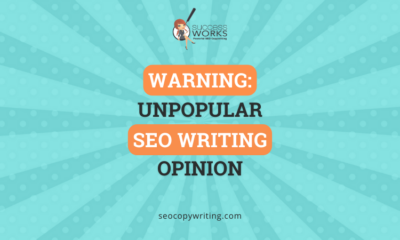MARKETING
PPC In 2020: 2 Experts Weigh In On Future Trends [Video]
Within our daily work lives at Hanapin, we have so many interesting PPC discussions across desk pods, at lunch, or through video chats. To be a fly on the wall for those conversations would be an informative experience! We want to bring some of those fascinating conversations to PPC Hero for our readers.
In this video, Hanapin’s Dani Gonzales and John Williams discuss the future of PPC and what’s on their wishlists for 2020.
Transcription
Dani:
Today we’re going to chat about the future of PPC. I’m joined by my coworker John Williams and before we fully dive in here we’ll go ahead and introduce ourselves.
I am a senior account manager here at Hanapin and I focus a lot on led gen campaigns particularly in B2B verticals, and I’m excited to share some fun stuff today.
John:
I’m John. I’ve been around for about 10 years in the digital industry and with Hanapin since July, which was a dream for me. I love everything whether it’s tag management, analytics, or paid search.
Dani:
You’ve been in the industry over 10 years, over that time what trends have surprised you the most in PPC?
John:
You can probably talk about the difference between using a PC or a Mac now and looking at an ad or you can talk about Google my business listings, or the 3-pack. There’s a lot that you can talk about, but for me, the absolute biggest has probably been attribution. We’ve always talked about it, but we didn’t really know what it was. Is it linear, is it time decay? Is a customer at the top of the funnel, are they at the bottom of the funnel? I think all of that’s out the door. I think we have to start looking at it a different way and I think a lot of the products that we’re using today are saying, look customers are over here on the left, and then on the top, and then they’re down here at the bottom. I think that’s the biggest for me is that the biggest change has been the progression of attribution and the technology behind it.
Dani:
I have to agree a little bit on the technology side.
So I’ve been in the industry less time than you just over three and a half years now and I think the thing that continually surprises me is that more and more we have access to so much data; audience data, demographic data, tons of micro bits of data, but we still struggle to report accurately across all the different data points we have from merging our client CRM data with what we’re seeing in the platform’s themselves. So I think that’s the one thing that I’m continually flummoxed by is how is it possible that we don’t have a really great source of truth for all of this information. Of course, I’m aware of the myriad of ad reporting software that’s available, but at the same time, it’s still something that I think is really surprising to me.
When you look ahead to 2020, is there anything that particularly excites you in the world of PPC? Any particular trends, features, consumer information – anything that you’re excited about?
John:
Yes, and no. I’m not really excited about all of the changes that are coming here to the US that means that as advertisers were going to start to see a lot of lot more propaganda on LinkedIn and Twitter about how something should be implemented or these leads aren’t really valid or are you doing this? So that doesn’t excite me.
What does excite me is that we’re learning how to be smarter advertisers. Meaning we’re asking better questions about our data from a strategy perspective. Everybody’s got an answer, everybody’s right. But you can’t always be right and I think we’re now starting to realize that as marketers, not just digital advertisers, that we need an objective that should be followed up with a strategy that helps us with the tactic.
Google’s walking along with us and so is Microsoft and our other partners that we have; they’re saying, stop doing all of the tactics in the day-to-day and start focusing on the things that actually matter. So that’s what excites me about going into 2020, I think we’ll see a lot more of that.
Dani:
My excitement goes along a similar trendline in terms of the automation features that we have available across managing all of our platforms. We can really hone in on the creative piece and focus on strategy and focus on the things that I think are really going to matter in 2020. Moving beyond, as all of these platforms get a lot more automated and we’re kind of letting go of the reins, there’s a couple of key pieces that we’re going to have to maintain really tight control of, and for me that’s creative and landing pages.
That’s going to be the place as advertisers we’re really going to be able to make a mark for our clients or if you’re doing your own digital advertising make a mark for yourself. I think really focusing on the creative components and the landing page experience is going to be a huge bit of what is going to make advertisers successful in 2020.
John:
Do you want to learn markup in HTML?
Dani:
No, I don’t know who wants to learn that but again, if it’s going to be a key component of helping our clients be more successful or at least being able to venture into the world of CRO and really get some solid multivariate testing on what’s going to work on landing pages for those individual clients. I don’t think we have to necessarily learn that ourselves as long as we have developers in our corner working on that and providing really strong testing results.
Again, I think the landing page experience is going to be a huge part of 2020 and we’ve seen that of course throughout the last few years with mobile AMP pages and all kinds of different landing page experiences. I think CRO is going to play a much larger role or we’re going to have to give it more credit than we may historically have.
If you could get Google and/or Facebook to make one huge update in 2020, what would it be?
John:
The biggest thing would probably be in Google. I love scripts, I want to learn JavaScript and python, I want to spend all my time doing that, but Google already has rules. So Google if you’re listening, you have rules. They function every 24 hours, can you just adjust it so that we can implement that every 12 hours? I would take that, but I would love to see the biggest change being rules changed to hourly so that we can start to work on things that matter for our clients and stop worrying about if we’re going to go over by 10% or worrying about coming up with a script that we need to calculate at 30% over or 30% under. Can we just get over that and utilize your tool and what you built it for?
Dani:
My number one wish list item, this comes up a lot especially again kind of coming back to the theme of automation and the more we implement automated pieces, we need data to make that possible. So we’re looking at the future of conversions. What does that look like? Do we start implementing micro-conversions so that we can get more data so those algorithms can be more powerful and we can use more of that machine learning? But within doing that, how we’re kind of rethinking what a conversion is and how we calculate this measure of success, I would really love if Google would just show me the corresponding data metrics with my conversion actions. Currently, if you have multiple conversion actions live in an account you can’t see the corresponding impressions, clicks, spend that was associated with those conversion actions. You can see the total and that’s it. So Google people if you are listening, please let me see key metrics alongside my conversion actions. It’s so little and I know you know it, and I know you have this information.
John:
You have to, you’re showing it in Google Analytics, so come on, give it to us. Just put it in one place. Why do we have to go to three places to look for things? One place, yes please.
Dani:
Anything else on your PPC wish list?
John:
It’d be great if we just had one tool. We have to go to too many places for reporting, for measurements, and then to take action. And we can’t afford it. Not everybody can afford an Adobe stack or Google marketing platforms. We can’t afford that and we shouldn’t have to use a third-party tool that interjects into our account to provide us with suggestions. It would be great if we had one tool that you can go in and see everything and do everything.
Dani:
To recap we want fewer tools overall, better tracking, and what was yours? More data analytics?
John:
The tracking, the measurements, and the tactic.
Dani:
And merging all of that into a cohesive story for your client is also pretty hard when you have to implement all of the different data points from all of the different platforms, which may or may not have similar attribution. You’re kind of running in a circle trying to present a really strong story that backs up your data, but then it’s really hard to plug it all in, get it centralized, and have it make sense in a way that’s really palatable.
John:
If it was your last ornament, what would that be? What would that last little thing that you wanted to like cap off your tree with for the holidays?
Dani:
I guess less from a platform perspective, but I want more of my clients doing video, higher quality video and focusing more on that. We’ve seen for some of my clients some really impressive brand lifts as a result. I think the better quality targeting that we’ve had in YouTube over the past year and some of the new capabilities like custom intent are really cool. I think that’s where I’d like to see that little ornament. A little shiny cherry on top would be just more video coming down from for my clients in particular.
John:
I like it. It takes a lot of work, but it is the brand appeal and how we’re moving away from TV and how we’re looking at the social components of things – it is 3 to 6-second bursts.
Dani:
I’m always troubled by clients being wary of YouTube or not wanting to run YouTube ads. For decades you were okay running TV ads when you have no idea who you’re targeting per se. We have so much more data we can get a lot more localized we can get a lot more segmented and that scares clients. I think it’s kind of funny reverse logic there. But I’m a big fan of YouTube, a big fan of running ads in that platform, especially given a lot of its more recent improvements.
Thanks again for listening everyone and we hope you join us again.
MARKETING
YouTube Ad Specs, Sizes, and Examples [2024 Update]
![YouTube Ad Specs, Sizes, and Examples [2024 Update] YouTube Ad Specs, Sizes, and Examples](https://articles.entireweb.com/wp-content/uploads/2024/06/YouTube-Ad-Specs-Sizes-and-Examples.jpg)
Introduction
With billions of users each month, YouTube is the world’s second largest search engine and top website for video content. This makes it a great place for advertising. To succeed, advertisers need to follow the correct YouTube ad specifications. These rules help your ad reach more viewers, increasing the chance of gaining new customers and boosting brand awareness.
Types of YouTube Ads
Video Ads
- Description: These play before, during, or after a YouTube video on computers or mobile devices.
- Types:
- In-stream ads: Can be skippable or non-skippable.
- Bumper ads: Non-skippable, short ads that play before, during, or after a video.
Display Ads
- Description: These appear in different spots on YouTube and usually use text or static images.
- Note: YouTube does not support display image ads directly on its app, but these can be targeted to YouTube.com through Google Display Network (GDN).
Companion Banners
- Description: Appears to the right of the YouTube player on desktop.
- Requirement: Must be purchased alongside In-stream ads, Bumper ads, or In-feed ads.
In-feed Ads
- Description: Resemble videos with images, headlines, and text. They link to a public or unlisted YouTube video.
Outstream Ads
- Description: Mobile-only video ads that play outside of YouTube, on websites and apps within the Google video partner network.
Masthead Ads
- Description: Premium, high-visibility banner ads displayed at the top of the YouTube homepage for both desktop and mobile users.
YouTube Ad Specs by Type
Skippable In-stream Video Ads
- Placement: Before, during, or after a YouTube video.
- Resolution:
- Horizontal: 1920 x 1080px
- Vertical: 1080 x 1920px
- Square: 1080 x 1080px
- Aspect Ratio:
- Horizontal: 16:9
- Vertical: 9:16
- Square: 1:1
- Length:
- Awareness: 15-20 seconds
- Consideration: 2-3 minutes
- Action: 15-20 seconds
Non-skippable In-stream Video Ads
- Description: Must be watched completely before the main video.
- Length: 15 seconds (or 20 seconds in certain markets).
- Resolution:
- Horizontal: 1920 x 1080px
- Vertical: 1080 x 1920px
- Square: 1080 x 1080px
- Aspect Ratio:
- Horizontal: 16:9
- Vertical: 9:16
- Square: 1:1
Bumper Ads
- Length: Maximum 6 seconds.
- File Format: MP4, Quicktime, AVI, ASF, Windows Media, or MPEG.
- Resolution:
- Horizontal: 640 x 360px
- Vertical: 480 x 360px
In-feed Ads
- Description: Show alongside YouTube content, like search results or the Home feed.
- Resolution:
- Horizontal: 1920 x 1080px
- Vertical: 1080 x 1920px
- Square: 1080 x 1080px
- Aspect Ratio:
- Horizontal: 16:9
- Square: 1:1
- Length:
- Awareness: 15-20 seconds
- Consideration: 2-3 minutes
- Headline/Description:
- Headline: Up to 2 lines, 40 characters per line
- Description: Up to 2 lines, 35 characters per line
Display Ads
- Description: Static images or animated media that appear on YouTube next to video suggestions, in search results, or on the homepage.
- Image Size: 300×60 pixels.
- File Type: GIF, JPG, PNG.
- File Size: Max 150KB.
- Max Animation Length: 30 seconds.
Outstream Ads
- Description: Mobile-only video ads that appear on websites and apps within the Google video partner network, not on YouTube itself.
- Logo Specs:
- Square: 1:1 (200 x 200px).
- File Type: JPG, GIF, PNG.
- Max Size: 200KB.
Masthead Ads
- Description: High-visibility ads at the top of the YouTube homepage.
- Resolution: 1920 x 1080 or higher.
- File Type: JPG or PNG (without transparency).
Conclusion
YouTube offers a variety of ad formats to reach audiences effectively in 2024. Whether you want to build brand awareness, drive conversions, or target specific demographics, YouTube provides a dynamic platform for your advertising needs. Always follow Google’s advertising policies and the technical ad specs to ensure your ads perform their best. Ready to start using YouTube ads? Contact us today to get started!
MARKETING
Why We Are Always ‘Clicking to Buy’, According to Psychologists

Amazon pillows.
MARKETING
A deeper dive into data, personalization and Copilots

Salesforce launched a collection of new, generative AI-related products at Connections in Chicago this week. They included new Einstein Copilots for marketers and merchants and Einstein Personalization.
To better understand, not only the potential impact of the new products, but the evolving Salesforce architecture, we sat down with Bobby Jania, CMO, Marketing Cloud.
Dig deeper: Salesforce piles on the Einstein Copilots
Salesforce’s evolving architecture
It’s hard to deny that Salesforce likes coming up with new names for platforms and products (what happened to Customer 360?) and this can sometimes make the observer wonder if something is brand new, or old but with a brand new name. In particular, what exactly is Einstein 1 and how is it related to Salesforce Data Cloud?
“Data Cloud is built on the Einstein 1 platform,” Jania explained. “The Einstein 1 platform is our entire Salesforce platform and that includes products like Sales Cloud, Service Cloud — that it includes the original idea of Salesforce not just being in the cloud, but being multi-tenancy.”
Data Cloud — not an acquisition, of course — was built natively on that platform. It was the first product built on Hyperforce, Salesforce’s new cloud infrastructure architecture. “Since Data Cloud was on what we now call the Einstein 1 platform from Day One, it has always natively connected to, and been able to read anything in Sales Cloud, Service Cloud [and so on]. On top of that, we can now bring in, not only structured but unstructured data.”
That’s a significant progression from the position, several years ago, when Salesforce had stitched together a platform around various acquisitions (ExactTarget, for example) that didn’t necessarily talk to each other.
“At times, what we would do is have a kind of behind-the-scenes flow where data from one product could be moved into another product,” said Jania, “but in many of those cases the data would then be in both, whereas now the data is in Data Cloud. Tableau will run natively off Data Cloud; Commerce Cloud, Service Cloud, Marketing Cloud — they’re all going to the same operational customer profile.” They’re not copying the data from Data Cloud, Jania confirmed.
Another thing to know is tit’s possible for Salesforce customers to import their own datasets into Data Cloud. “We wanted to create a federated data model,” said Jania. “If you’re using Snowflake, for example, we more or less virtually sit on your data lake. The value we add is that we will look at all your data and help you form these operational customer profiles.”
Let’s learn more about Einstein Copilot
“Copilot means that I have an assistant with me in the tool where I need to be working that contextually knows what I am trying to do and helps me at every step of the process,” Jania said.
For marketers, this might begin with a campaign brief developed with Copilot’s assistance, the identification of an audience based on the brief, and then the development of email or other content. “What’s really cool is the idea of Einstein Studio where our customers will create actions [for Copilot] that we hadn’t even thought about.”
Here’s a key insight (back to nomenclature). We reported on Copilot for markets, Copilot for merchants, Copilot for shoppers. It turns out, however, that there is just one Copilot, Einstein Copilot, and these are use cases. “There’s just one Copilot, we just add these for a little clarity; we’re going to talk about marketing use cases, about shoppers’ use cases. These are actions for the marketing use cases we built out of the box; you can build your own.”
It’s surely going to take a little time for marketers to learn to work easily with Copilot. “There’s always time for adoption,” Jania agreed. “What is directly connected with this is, this is my ninth Connections and this one has the most hands-on training that I’ve seen since 2014 — and a lot of that is getting people using Data Cloud, using these tools rather than just being given a demo.”
What’s new about Einstein Personalization
Salesforce Einstein has been around since 2016 and many of the use cases seem to have involved personalization in various forms. What’s new?
“Einstein Personalization is a real-time decision engine and it’s going to choose next-best-action, next-best-offer. What is new is that it’s a service now that runs natively on top of Data Cloud.” A lot of real-time decision engines need their own set of data that might actually be a subset of data. “Einstein Personalization is going to look holistically at a customer and recommend a next-best-action that could be natively surfaced in Service Cloud, Sales Cloud or Marketing Cloud.”
Finally, trust
One feature of the presentations at Connections was the reassurance that, although public LLMs like ChatGPT could be selected for application to customer data, none of that data would be retained by the LLMs. Is this just a matter of written agreements? No, not just that, said Jania.
“In the Einstein Trust Layer, all of the data, when it connects to an LLM, runs through our gateway. If there was a prompt that had personally identifiable information — a credit card number, an email address — at a mimum, all that is stripped out. The LLMs do not store the output; we store the output for auditing back in Salesforce. Any output that comes back through our gateway is logged in our system; it runs through a toxicity model; and only at the end do we put PII data back into the answer. There are real pieces beyond a handshake that this data is safe.”
-

 SEARCHENGINES5 days ago
SEARCHENGINES5 days agoBillions Of Google goo.gl URLs To 404 In The Future
-

 SEO7 days ago
SEO7 days ago26 Common SEO Myths, Debunked
-
SEARCHENGINES4 days ago
Daily Search Forum Recap: July 22, 2024
-

 SEARCHENGINES6 days ago
SEARCHENGINES6 days agoGoogle Core Update Coming, Ranking Volatility, Bye Search Notes, AI Overviews, Ads & More
-

 SEO5 days ago
SEO5 days ago11 Copyscape Alternatives To Check Plagiarism
-

 SEO6 days ago
SEO6 days agoGoogle Warns Of Last Chance To Export Notes Search Data
-
SEARCHENGINES3 days ago
Daily Search Forum Recap: July 23, 2024
-

 AFFILIATE MARKETING6 days ago
AFFILIATE MARKETING6 days agoThe Top 5 AI Tools That Can Revolutionize Your Workflow and Boost Productivity















